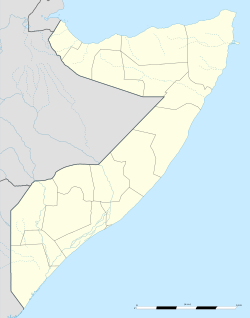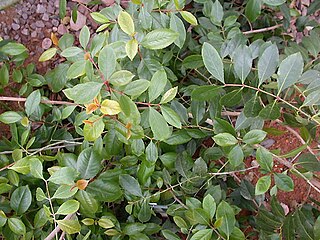
Khat or qat is a flowering plant native to eastern and southern Africa. Khat contains the alkaloid cathinone, a stimulant which causes greater sociability, excitement, loss of appetite, and mild euphoria. Among communities from the areas where the plant is native, khat-chewing has historical relevance dating back thousands of years, analogous—but slightly different—to the use of coca leaves in South America’s Andes Mountains or the betel nut preparations in South Asia; khat is often chewed socially, to stimulate conversation among groups of men in a lounge, smoking hookah.

Lutefisk is dried whitefish, usually cod, but sometimes ling or burbot, cured in lye. It is made from aged stockfish, or dried and salted cod. The fish takes a gelatinous texture after being rehydrated for days prior to eating.

A heat pump is a device that uses work to transfer heat from a cool space to a warm space by transferring thermal energy using a refrigeration cycle, cooling the cool space and warming the warm space. In cold weather a heat pump can move heat from the cool outdoors to warm a house; the pump may also be designed to move heat from the house to the warmer outdoors in warm weather. As they transfer heat rather than generating heat, they are more energy-efficient than other ways of heating a home.
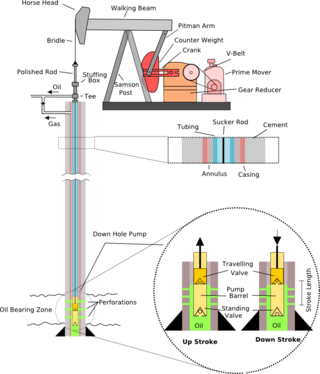
A pumpjack is the overground drive for a reciprocating piston pump in an oil well.

Marinejegerkommandoen (MJK) is the maritime/naval special warfare unit of the Norwegian Armed Forces and was established in 1953.

Geothermal heating is the direct use of geothermal energy for some heating applications. Humans have taken advantage of geothermal heat this way since the Paleolithic era. Approximately seventy countries made direct use of a total of 270 PJ of geothermal heating in 2004. As of 2007, 28 GW of geothermal heating capacity is installed around the world, satisfying 0.07% of global primary energy consumption. Thermal efficiency is high since no energy conversion is needed, but capacity factors tend to be low since the heat is mostly needed in the winter.

The Frogman Corps is the maritime special operations force of the Danish Armed Forces part of Special Operations Command. On 1 July 2015, the Frogman Corps transferred from the Royal Danish Navy to the newly established Special Operations Command.
Seasonal thermal energy storage (STES), also known as inter-seasonal thermal energy storage, is the storage of heat or cold for periods of up to several months. The thermal energy can be collected whenever it is available and be used whenever needed, such as in the opposing season. For example, heat from solar collectors or waste heat from air conditioning equipment can be gathered in hot months for space heating use when needed, including during winter months. Waste heat from industrial process can similarly be stored and be used much later or the natural cold of winter air can be stored for summertime air conditioning.

An air source heat pump (ASHP) is a heat pump that can absorb heat from air outside a building and release it inside; it uses the same vapor-compression refrigeration process and much the same equipment as an air conditioner, but in the opposite direction. ASHPs are the most common type of heat pump and, usually being smaller, tend to be used to heat individual houses or flats rather than blocks, districts or industrial processes.

A ground source heat pump is a heating/cooling system for buildings that uses a type of heat pump to transfer heat to or from the ground, taking advantage of the relative constancy of temperatures of the earth through the seasons. Ground source heat pumps (GSHPs) – or geothermal heat pumps (GHP) as they are commonly termed in North America – are among the most energy-efficient technologies for providing HVAC and water heating, using far less energy than can be achieved by burning a fuel in a boiler/furnace or by use of resistive electric heaters.

The Somali diaspora or Qurbajoogta refers to Somalis who were born in Greater Somalia and reside in areas of the world that they were not born in. The civil war in Somalia greatly increased the size of the Somali diaspora, as many Somalis moved from Greater Somalia primarily to Europe, North America, Southern Africa and Australia. There are also small Somali populations in other pockets of Europe and Asia. The UN estimates that in 2015, approximately 2 million people from Somalia were living outside of the country's borders.

Maydh is an ancient port city in the eastern Sanaag region of Somaliland.
Nettavisen is a Norwegian online newspaper, launched in 1996 as the first online-only newspaper in Norway. The current editor is Gunnar Stavrum. As of 2015, it was one of Norway's most popular news websites.
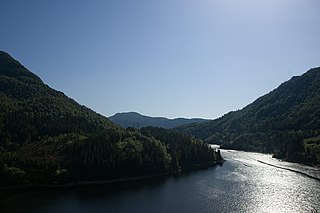
Svartediket is a lake in the city of Bergen in Vestland county, Norway. The 0.5-square-kilometre (0.19 sq mi) lake lies immediately north of the mountain Ulriken, northeast of the Store Lungegårdsvannet bay. Historically, this lake was called Ålrekstadsvannet, but in the late 19th century, a dam was built on the south end of the lake to create a reservoir for the city's drinking water. The lake is the main source of drinking water for the central parts of the city of Bergen. There is a pumping station and treatment facility build adjacent to the lake inside the mountain Ulriken. Drinking water is collected at a 28-metre (92 ft) depth in Svartediket. Inside the water treatment plant, the water is filtered and irradiated with UV light to kill harmful microorganisms. After treatment, the clean drinking water is stored in a 15,000-cubic-metre (530,000 cu ft) large water pool inside the mountain. This is the water that is pumped down to the city center for drinking water. In 2004, Bergen was hit by a Giardia lamblia epidemic which had its source in the lake Svartediket. The water treatment facility was upgraded in 2007.

Ulla-Førre is a hydropower complex in Southern Norway. It is situated along the borders of the municipalities of Suldal and Hjelmeland and Bykle, Norway. It has an installed capacity of approximately 2,100 megawatts (2,800,000 hp), and the annual average production is 4.45 TWh (16.0 PJ) (1987–2006), while its reservoir capacity is about 7.8 TWh (28 PJ); at full production, it can last seven to eight months. The complex includes the artificial lake Blåsjø, which is made by dams around 1,000 metres (3,300 ft) above the sea level. The hydroelectric power stations in the complex are Saurdal, Kvilldal, Hylen and Stølsdal, operated by Statkraft.
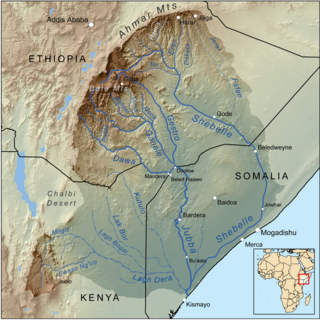
Ganale Doria is a dam located near Genale on the river Shabelle. It was built in the south of Somalia in the 1920s along with an extensive network of canals. The dam was strongly promoted by Cesare Maria De Vecchi - Italian governor of Italian Somalia from 1924 to 1928 - in order to provide water for irrigation of a vast territory between Genale, Merca and Vittorio di Africa, to be given in concession to colonists.

Alisha Ilhaan Bø, known professionally as Alisha Boe, is an actress based in United States. She is known for playing Jessica Davis in the Netflix drama series 13 Reasons Why.

Abdikadir Mohamed Abdikadir, better known as Ikrima, is a terrorist described as one of the most dangerous commanders of the Somali terror organisation Al-Shabaab. He has reportedly been central in the planning of several terror attacks, and responsible for forging links between Al-Shabaab and Al-Qaeda in the Arabian Peninsula (AQAP). He is of Somali ethnicity.

Hassan Ali Khaire, popularly known as Hassan Khaire, is a senior politician and is the former Prime Minister of Somalia. He was appointed on 23 February 2017 by Somalia President Mohamed Abdullahi Mohamed "Farmaajo" and resigned on Saturday July 25, 2020 after MPs passed a disputed vote of no confidence.
Somalis in Norway are citizens and residents of Norway who are of Somali descent. They are the biggest African migration group in Norway. 36.5% of Somalis in Norway live in the capital Oslo. Almost all Somali in Norway have come to Norway as refugees from the Somali Civil War. In 2016, Somalis were the largest non-European migrant group in Norway.
